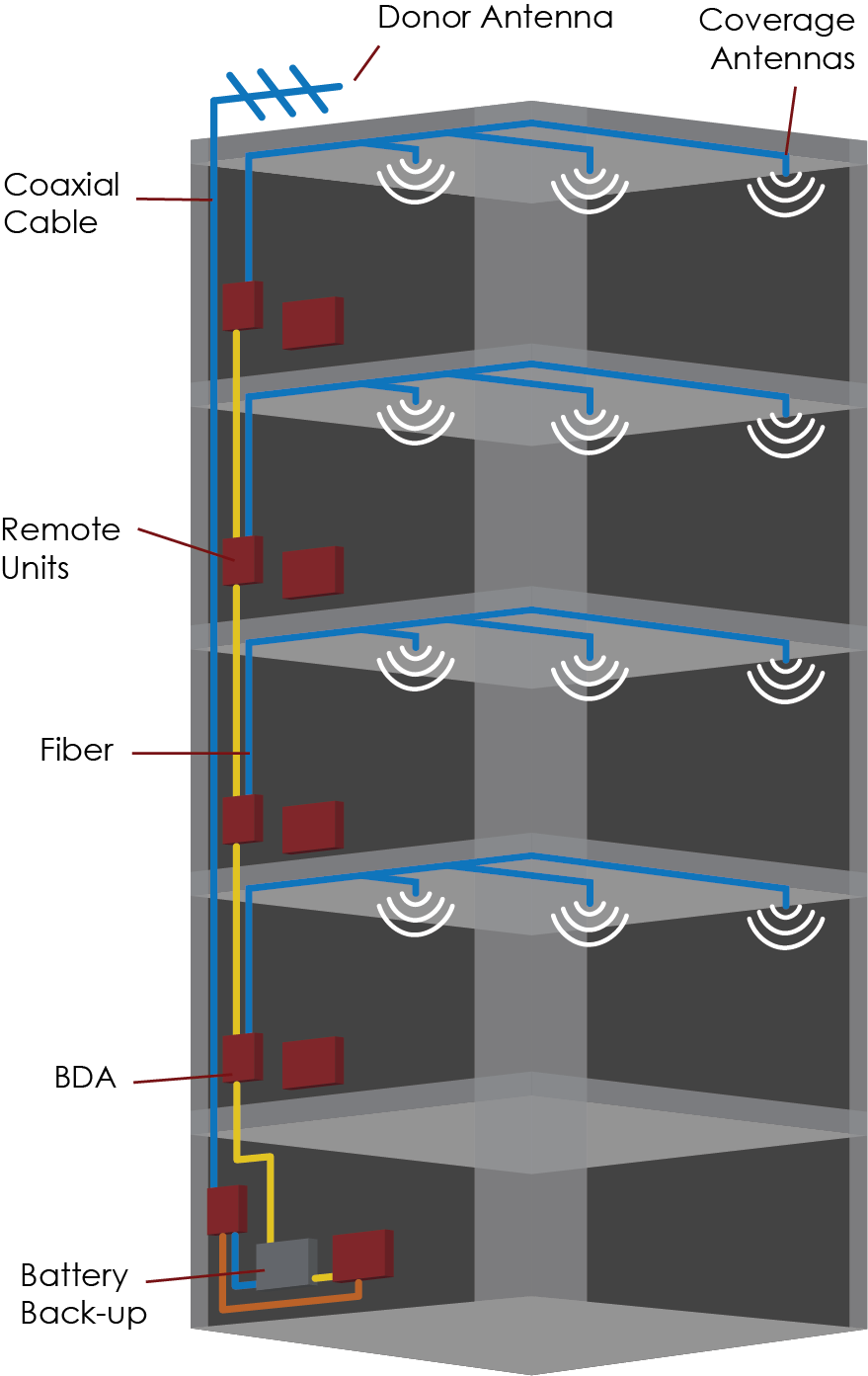ERRC and DAS Systems: What You Need to Know
We live in a world that relies on various wireless technologies to communicate with one another. For the general consumer, infrastructure elements such as strong cellular, radio, and Wi-Fi signals have moved beyond being a luxury into a matter of safety and security. Radio and cellular signals are often weakened in large buildings and other venues due to a variety of factors, such as radio frequency interference, low-emissivity glass, concrete, and other building materials. These obstacles create areas within the structure that have little-to-no signal, rendering radios and cellular phones useless. Not only is this a source of frustration for building occupants, but it also interferes with the communication of first responders in cases of emergency; however, there are ways to mitigate these issues. Distributed Antenna Systems (DAS) improve cellular connectivity for occupants while Emergency Responder Radio Coverage (ERRC) systems address code-required signal levels of communication for Police, Fire, and other emergency personnel.
The History of DAS

A Distributed Antenna System, or DAS, is a dedicated antennae network that allows personal cellular signals to be sent and received within a building, hospital, hotel, or other large venue. It typically uses a given carrier’s licensed frequencies and greatly improves voice and data connectivity for occupants inside these structures. Initially, cellular service was considered an exclusive agreement between the service provider and the properties that utilized their DAS frequencies. This was problematic for inhabitants that used a different provider, as they did not have access to a signal strong enough to provide reliable service. Another concern for those who lived or worked in taller buildings was that cellular signals weaken as the distance between a user and the signal increases. Fortunately, the evolution of these systems has made them more streamlined, allowing demarcation points to shift from property lines and MDF rooms to individual offices and/or units, thereby strengthening connectivity. Best practices for effective DAS design and application have been set forth by the Building Industry Consulting Services International (BICSI) and the Telecommunications Industry Association (TIA). DAS requirements remain stringent for government buildings; however, multi-family and hospitality Owners and Developers are able to utilize alternative methods such as Wi-Fi to maintain adequate signal strength to ensure connectivity for building tenants and staff.
DAS and Wi-Fi
Innovations in wireless technology have allowed Wi-Fi to add additional communication options to the architecture, engineering, and construction industries. It has become an increasingly popular alternative to trusting cellular networks alone and can usually be found in common areas of multifamily properties, across college campuses, and throughout offices and hotels. While Wi-Fi is a viable alternative to cellular signals, it can still fail if a user’s signal is weak. That failure can quickly become dangerous if that user is a first responder. In 2018, new requirements were initiated to strengthen wireless connectivity inside buildings, ensuring that communication would be available when wanted and, more importantly, when needed.
The Rise of ERRC
Emergency Responder Radio Coverage (ERRC) refers to the code requirements surrounding radio strength within a building. It is similar to DAS but utilizes different frequencies and legalities. Its main purpose is to help firefighters, police officers, and paramedics establish points of operation and communication, allowing them to respond to emergencies within buildings without the risk of losing signal. While it is possible to use ERRC in place of a DAS or Wi-Fi connectivity, it is inadvisable to do so as ERRC is intended to run on one antenna using one frequency; adding additional frequencies for non-emergency communication is cost-prohibitive, making a separate DAS or robust Wi-Fi system a better option for everyday communications.
Before ERRC was developed, emergency personnel often wasted valuable time and resources finding an outdoor location with a signal strong enough to support their radio communication both inside and outside a given building. ERRC codes and standards not only regulate the signal strength and frequency requirements, they also facilitate software with graphics for police, firefighters, and medics to track and monitor where personnel are located while onsite; however, despite these valuable benefits to first responders, these types of systems present specific design challenges that are best piloted by Federal Communications Commission (FCC)-licensed partners both because of their cost and safety implications.
Equipment needs for adequate service can vary because the strength of a signal inside a building can differ based on a number of factors, including what the building is made from or its proximity to a first responder radio tower. Some projects may not need any additional equipment to boost signal strength. Projects located in areas where towers are less prevalent or where buildings are made from certain materials may require a more robust system to support a signal strong enough to ensure the safety of occupants and first responders. Also, installation costs can vary by manufacturer and location, potentially resulting in higher-than-expected initial expenses.
iBwave software can be used by system integrators to conduct Predictive Signal Studies prior to construction to measure radio signals and predict whether the potential building will meet current requirements; however, these predictive tests can be costly. For buildings with little access above ceilings, low voltage and communications engineers can design effective infrastructure for ERRC in the form of conduits, junction boxes, and allocated equipment space to allow for the future installation of antennae as determined by the required signal strength test.
Experienced engineers, such as those at Jordan & Skala Engineers, are needed to produce cost-effective, flexible designs that meet both code requirements and project goals.
Code Updates and Their Impact

The importance of improving indoor connectivity for first responders came to light after the release of the Post-9/11 Commission Report in 2005. Before this, fire fighters relied upon phone jacks installed near stairways for communication indoors with personnel in the building’s fire control room. While having adequate radio signals indoors renders the jacks unnecessary, some building codes still require them to be installed unless exempted by the respective fire marshal. In some cases, fire marshals may need to be educated on ERRC applications and prevalence in contrast to what has been done in the past.

Subsequent building code updates have been enacted to ensure proper indoor signal strength for both new and existing buildings. While these updated codes are determined by authorities having jurisdiction (AHJ) and can sometimes be jurisdictionally driven, fire code officials are in charge of approving the system and required frequencies. For system installation, an FCC-issued General Radio Operator’s License (GROL) is required, as well as training and OEM Certification or skill considered satisfactory to the AHJ. Buildings with emergency generators now only require 2-hours of battery backup while buildings with no emergency generator require 12-hours of battery backup. There are also minimum requirements for inbound and outbound signals’ delivered audio quality.
In the most recent version of the IFC code, signal boosters and system monitoring protocols were revised, including:
- Battery systems for emergency power must be housed in NEMA 3R cabinets.
- Any donor antenna must be isolated from interior antennae no less than 20dB greater than the system gain under all operating conditions.
- Installing system amplifiers, or any system that might interfere with an ERRC system, must be coordinated and approved by the fire code official.
- ERRC systems must be monitored by a fire alarm control unit or sound an audible alarm, as approved by a fire code official.
- Repositioning or relocation of the donor antenna, once initially installed, requires approval by the fire code official.
- There should also be automatic signals for any of the following: loss of AC power supply, battery charge and RF-emitting device failures, antenna malfunctions, failure of critical system components, and for communication links between the fire alarm system and the emergency responder radio enhancement system.
Regarding existing buildings without an approved communication system, one can be installed within a timeframe established by the AHJ. While it’s the building Owner’s responsibility to adhere to the code and meet any annual recertification requirements, project partners can provide plans to help meet code requirements. System integrators must design and install ERRC systems using FCC-certified equipment in NEMA-4 enclosures. Signal testing falls under the responsibility of the Owner, integrator, and occasionally a third-party, and is required to be completed annually.
According to the current code, a building’s signal strength must meet code minimums in at least 95% of all areas and 99% of areas deemed critical areas by the fire code official. Contractors that provide the designs and installation of ERRC systems must be licensed by the FCC.
The Cost of Lacking Coverage
ERRC and DAS can be retroactively implemented for existing buildings; however, the time, resources, and coordination to do so can complicate the process for many Owners and Developers. Fire marshals can bring a project to a halt during the final stages if signal strength standards are not fully met. If you leave these systems out of the planning and design phases of a project, one risks incurring additional expenses and subsequently rushing other phases of construction to stay on task. Retrofitting ERRC and DAS systems during or after construction often results in higher rates from project partners, due to an increase in the amount of coordination and materials needed to modify signal strength and coverage. For example, cables for emergency generators are typically inexpensive, but the price can rise to six times that amount for out-of-sequence system construction. In the near future, building codes may require annual signal strength testing, which will shrink the margin of error for system planning and implementation. When this update takes effect, it is best addressed by seasoned partners who can expertly plan and design ERRC and DAS communication systems, as well as coordinate signal strength testing efficiently, like Jordan & Skala Engineers.
ERRC and DAS: In Closing
DAS and Wi-Fi connectivity are highly technical systems and require experienced project partners to ensure that best practices are being adhered to. ERRC systems for emergency responders require coordination with FCC-licensed partners, code compliance, and extraordinary attention to detail.
Wireless connectivity is critical to safety, efficiency, and user comfort on developed properties, and Owners and Developers face important decisions when planning and constructing effective ERRC and DAS systems for voice and data communication. Our seasoned low voltage and communications engineers at Jordan & Skala can provide the technical expertise necessary, as well as design effective communication systems that balance both building codes and project goals.
Download Guide
Learn more about ERRC and DAS by downloading our guide.

Leave a Reply
Want to join the discussion?Feel free to contribute!